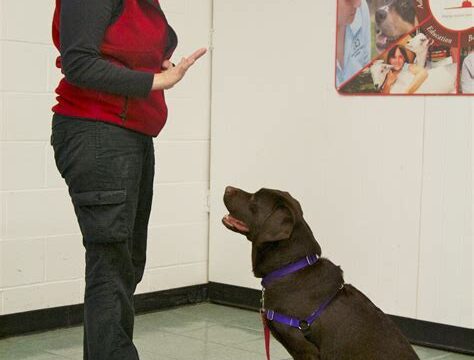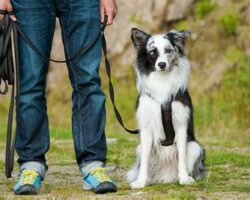Learn basic obedience commands, positive reinforcement techniques, and leadership in dog training. Socialize with other dogs and get tips for consistency and be
Basic Obedience Commands
Basic obedience commands are the foundation of a well-behaved canine. Teaching your dog commands such as sit, stay, and come are essential for their safety and your peace of mind. These commands not only help with controlling your dog in different situations, but also contribute to building a strong bond between you and your pet. When teaching these commands, it’s important to use positive reinforcement techniques such as treats, praise, and affection to encourage the desired behavior.
Consistency in training methods is crucial when teaching basic obedience commands. It’s important to use the same verbal cues and hand signals every time you ask your dog to perform a command. This helps in reinforcing the association between the command and the desired behavior. Additionally, establishing leadership and boundaries in your training sessions will help your dog understand their role in the pack and follow your instructions more willingly.
Remember to be patient and understanding while training your dog. Each dog learns at their own pace, so it’s important not to get frustrated if they don’t grasp a command right away. With practice and behavioral correction strategies, such as redirecting unwanted behavior and ignoring bad behavior, your dog will eventually learn and obey basic commands consistently.
Positive Reinforcement Techniques
Positive reinforcement is a powerful tool for training your dog. It involves rewarding your dog for good behavior, rather than punishing them for bad behavior. By using positive reinforcement, you can strengthen the behaviors you want to see in your dog, and gradually eliminate the ones you don’t. This method is based on the principle that dogs will repeat behaviors that are rewarded, so by using rewards such as treats, praise, or playtime, you can encourage your dog to display the desired behaviors.
One of the key aspects of positive reinforcement is timing. It’s important to reward your dog immediately after they exhibit the desired behavior, so they can make the connection between the behavior and the reward. Consistency is also crucial when using positive reinforcement. You should reward your dog every time they display the desired behavior, until the behavior becomes a habit.
Another important aspect of positive reinforcement is to be patient and persistent. Training takes time and effort, so it’s important to stay consistent with your rewards and keep practicing until your dog fully learns the behavior. It’s also important to use a variety of rewards and to keep training sessions fun and engaging for your dog, so they stay motivated to learn and improve.
Establishing Leadership and Boundaries
Establishing Leadership and Boundaries
Establishing Leadership and Boundaries in dog training is crucial for creating a well-behaved and balanced canine companion. Dogs are pack animals by nature and thrive in a structured environment where they understand their place in the hierarchy. As the pet owner, it is your responsibility to establish yourself as the leader and set clear boundaries for your furry friend to follow.
One of the most effective ways to establish leadership and boundaries is through consistent training. Dogs thrive on routine and predictability, so it’s important to set clear rules and expectations and stick to them. This may include setting boundaries for behavior, such as not allowing your dog on the furniture or ensuring they wait to be invited before entering or exiting a room. Consistency in enforcing these rules will help your dog understand their place in the pack and what is expected of them.
Another important aspect of establishing leadership and boundaries is asserting your authority in a calm but firm manner. This can be achieved through confident body language, consistent verbal cues, and the use of positive reinforcement to reward good behavior. It’s important to be consistent in your approach and avoid sending mixed signals, as this can confuse your dog and lead to behavioral issues. By establishing yourself as a strong, fair leader, you will earn your dog’s respect and trust, making training much more effective.
Socialization with Other Dogs
When it comes to socializing your dog with other canines, it’s important to start early and make it a regular part of their routine. Positive reinforcement techniques can be incredibly effective in promoting good behavior during these interactions. If your dog remains calm and friendly while interacting with other dogs, be sure to praise and reward them for their good behavior.
Establishing leadership and boundaries in the presence of other dogs is also crucial. By consistently reinforcing your role as the pack leader, your dog will be more likely to follow your lead and behave appropriately in social situations. This can help prevent any potential conflicts or aggression towards other dogs.
Consistency in training methods is key when it comes to socializing your dog with other canines. By using the same commands and techniques during every interaction with other dogs, your furry friend will learn what is expected of them and how to behave around their peers.
Consistency in Training Methods
Consistency in training methods is a crucial aspect of ensuring your canine companion learns and retains obedience commands. One of the key elements of effective training is repetition, which helps reinforce the desired behavior. Consistently using the same verbal cues and hand signals for each command allows your dog to understand and respond appropriately to your instructions.
Additionally, maintaining a consistent training schedule is essential for success. Dogs thrive on routine, and setting aside dedicated time each day for training sessions helps establish a predictable learning environment for your pet. This regularity also reinforces the expectations and boundaries you have set, aiding in the overall training process.
Furthermore, it is important to remain consistent in your own behavior during training. This means adhering to the same rules and expectations for your dog each day, as well as using positive reinforcement techniques consistently. Inconsistencies in your reactions to your dog’s behavior can lead to confusion and hinder their understanding of what is expected of them.
Behavioral Correction Strategies
One important aspect of dog training is behavioral correction strategies, which are essential for addressing undesirable behaviors and fostering positive habits in your canine companion. Instead of punishing your dog for misbehavior, it’s important to understand the underlying cause and use positive reinforcement to encourage the desired behavior. By using positive reinforcement techniques such as treats, praise, and toys, you can effectively redirect your dog’s attention and encourage them to exhibit more desirable behaviors.
Consistency in training methods is also crucial when implementing behavioral correction strategies. Dogs thrive on routine and structure, so it’s important to remain consistent in your commands, expectations, and rewards. This consistency will help your dog understand what is expected of them and reinforce positive behaviors over time.
In addition to consistency, establishing leadership and boundaries is an essential component of behavioral correction strategies. Dogs are pack animals and crave structure and leadership. By establishing yourself as the leader and setting clear boundaries, you can effectively guide your dog towards more positive behaviors and discourage negative habits.
Exercise and Mental Stimulation
Exercise and Mental Stimulation for your Canine
Dogs, like humans, require regular physical exercise to maintain good health. This includes daily walks, runs, or playtime in the yard. Regular exercise helps to keep your dog’s weight in check, strengthens muscles, and improves overall cardiovascular health. It also provides an opportunity for mental stimulation, as your dog will encounter new sights, sounds, and smells during outdoor activities.
Aside from physical exercise, it’s crucial to provide mental stimulation for your furry friend. This can be achieved through interactive toys, puzzle games, or training exercises that encourage problem-solving. Engaging your dog’s mind is just as important as keeping their body active, and it can prevent boredom and destructive behaviors.
Remember to tailor your dog’s exercise routine to their specific needs. High-energy breeds may require more intense physical activity, while older or smaller dogs may need gentler forms of exercise. As a responsible pet owner, it’s important to strike a balance between exercise and mental stimulation to ensure your canine companion leads a happy and fulfilling life.
Frequently Asked Questions
What are the most important dog training tips for a well-behaved canine?
Some important dog training tips include positive reinforcement, consistency, patience, and proper socialization.
How can I use positive reinforcement in dog training?
You can use treats, praise, and toys as positive reinforcements to encourage good behavior in your dog.
Why is consistency important in dog training?
Consistency helps your dog understand what is expected of them and reinforces good behavior.
What role does patience play in dog training?
Patience is crucial in dog training as it takes time for a dog to learn and adapt to new behaviors.
How can I properly socialize my dog?
Proper socialization involves exposing your dog to various people, animals, environments, and experiences in a positive and controlled manner.
What should I do if my dog exhibits unwanted behavior?
If your dog exhibits unwanted behavior, redirect their attention, avoid punishment, and seek professional help if necessary.
Can I train an older dog, or is it better to start training a puppy?
It is possible to train older dogs, but starting training at a young age is generally recommended for easier and more effective training.





